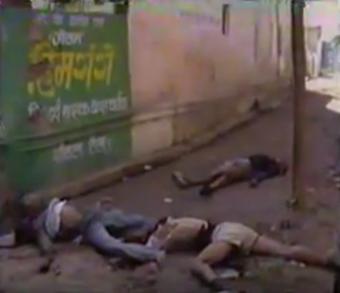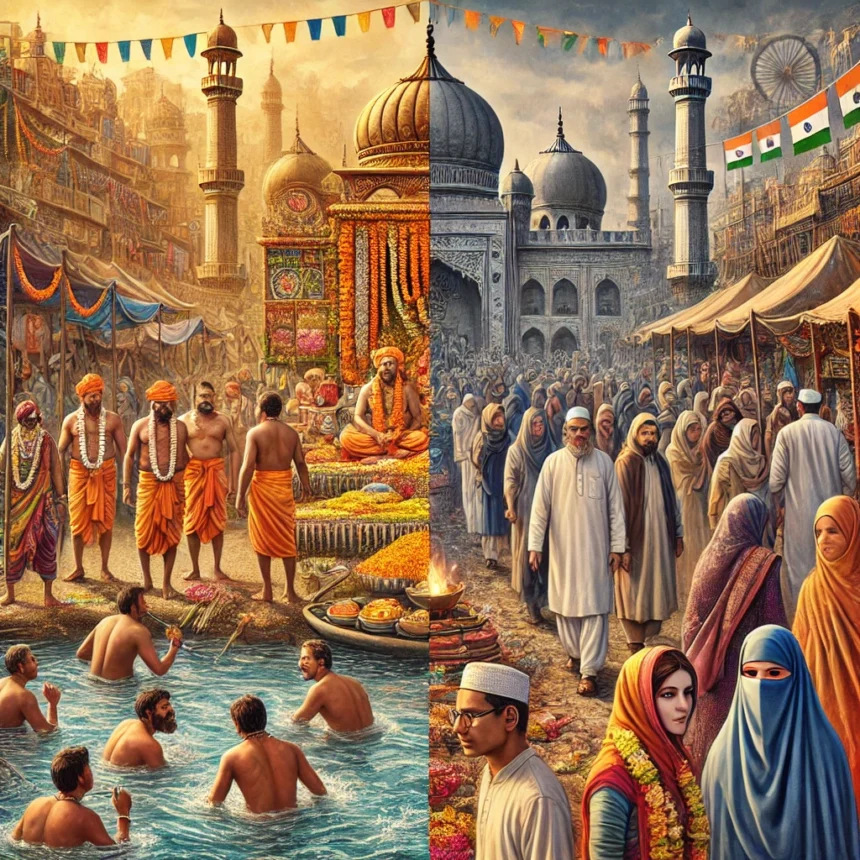Maha Kumbha Mela 2025: Analyzing Mad Rush of Hindus to Holy Waters-I
Analyzing Mad Rush to Maha Kumbha Mela
Welcome to our two-part blog series on Maha Kumbha Mela 2025, where we explore the myriad facets of this sacred event driving an extraordinary Hindu pilgrimage! In Part 1, we lay the groundwork by examining the historical and logistical roots behind the fervent participation in this grand spiritual and cultural spectacle known as Maha Kumbha. We’ll also spotlight the remarkable management acumen of the administration, guided by the unique leadership of a sanyasi (ascetic) and a devoted Hindu believer, whose efforts have not only orchestrated this monumental gathering but also fueled the unprecedented “mad rush” to the Kumbh Mela.
Our journey begins with a deep dive into the compelling reasons that draw millions of Hindus to this ancient festival, transcending barriers of wealth, caste, and nationality to unite in the sacred act of the holy dip. Join us as we uncover the foundational elements of Maha Kumbha Mela 2025—what makes it a logistical marvel and a crucible of suppressed aspirations—and set the stage for Part 2, where we’ll reveal how these forces culminate in a powerful resurgence of Hindu identity and spirit.
Background
The Maha Kumbha Mela is one of the oldest and most significant spiritual gatherings globally, rooted in the enchanting tales of Hindu mythology. Legend has it that during a celestial battle over the nectar of immortality, drops fell at four sacred sites in India—Haridwar, Prayagraj, Nashik, and Ujjain. These sites host the Kumbh Mela every 12 years, drawing millions for a holy dip in the rivers, believed to purify the soul and grant spiritual rebirth.
In our series on the Maha Kumbha Mela 2025, we explore the event’s vast scale, which combines deep devotion with complex logistics. From the planning required to accommodate millions of pilgrims to the seamless execution of traffic control and sanitation, every facet of the festival reflects a blend of ancient tradition and modern innovation. Our coverage includes firsthand accounts of spiritual journeys, the logistical challenges faced by organizers, and the sophisticated systems in place to ensure safety and manage the environmental impact.
As we continue to explore the rich tapestry of experiences that define the Maha Kumbha Mela, join us in understanding how this grand event not only reinforces spiritual bonds but also showcases the enduring resilience and unity of the Hindu community.
The Story of Suppression of Hindus
Having set the stage for an in-depth investigation, let’s delve into the primary reasons behind the fervent participation in the Maha Kumbha Mela. Foremost among these is the historical and ongoing suppression of Hindus across India, a narrative that began under British colonial rule with their divide-and-rule policy and has persisted in various forms in independent India. Layered atop this national context is an even more intense reality within Uttar Pradesh, the very state hosting Mahakumbh, where successive governments over the past 30-40 years have been accused of excessively oppressing Hindus through direct and violent actions. Together, these dual threads of suppression—national and regional—fuel a profound drive among Hindus to reclaim their spiritual and cultural identity, with Mahakumbh emerging as a powerful outlet for this resurgence.
The narrative of Hindu suppression or marginalization has been a contentious topic in India’s post-independence era, often stifled by the fear of being labeled anti-secular.
Hindu Supression In Uttar Pradesh

Similarly, the Sambhal riots of 1978 and subsequent unrest highlight a pattern of unfair treatment. During the 1978 violence, reportedly 184 Hindus were killed, yet the cases were buried or withdrawn under later administrations, including Mulayam Singh Yadav’s in 1993, when half of the 16 related FIRs were quietly dropped. Victims faced murder, arson, and displacement, yet justice remained elusive, reinforcing the sense of systemic neglect. These events, alongside others like the Muzaffarnagar riots of 2013, paint a picture of governments in Uttar Pradesh as direct oppressors, often prioritizing political appeasement over equitable treatment.
Many of these and other incidents had initiated migration of Hindus from many areas of Uttar Pradesh including from Sambhal.
Religious Disparities in Legal Frameworks
Post-1947, India adopted a secular framework intended to ensure equality among religions. However, laws and policies reveal a structure that, in application, often provides distinct protections or privileges to minorities while subjecting Hindu practices to stricter regulation, shaping the discourse around secularism in India:
Article 370 and Article 35A: Granted special autonomy and privileges to Jammu and Kashmir, predominantly benefiting its Muslim-majority population until their revocation in 2019.
Hindu Marriage Act of 1955: Reformed and standardized Hindu personal law under state oversight, while Muslim personal laws remained largely untouched by similar reforms.
Reservations and Minority-Specific Schemes: Allocate benefits like educational and job quotas based on religious identity, often favoring minority communities.
Autonomy Under Personal Laws: Grants minority religious practices significant independence, contrasting with state regulation of Hindu practices.
Shift in Perception Under BJP Governance: Since the BJP assumed power, there’s been a shift in how Hinduism is perceived politically. Gestures like temple visits by leaders, once criticized as anti-secular, are now reclaiming space, contrasting with earlier norms where hosting Iftar parties was lauded as secular.
Contrasting Management of Religious Institutions: Hindu temples remain under state control via Hindu Endowment Acts, while minority institutions, bolstered by laws like the Waqf Act, enjoy autonomy—sometimes exceeding judicial oversight. The 1991 Places of Worship Act further fuels discontent by locking historical claims.
Perceived Inequities in Secular Policies: These actions are seen as evidence of uneven secularism, a reality grounded in India’s socio-political fabric, driving Hindus to seek equal or greater rights.
Judicial Discrepancies in Interfaith Marriages: Legal biases in interfaith marriages—where Hindu converts often retain inheritance rights while Muslim converts lose them—underscore concerns of a one-way property transfer, further stoking resentment.
Hindu Liberalism
Decades of historical narratives and educational curricula, often influenced by colonial and post-independence biases, have fostered a sense of liberalism and tolerance among Hindus, depicting their traditions as adaptable or accommodating. This shift was made easier after the British dismantled traditional Hindu education systems through acts like the English Education Act of 1835, replacing gurukuls and pathshalas with a Westernized framework that sidelined Hindu cultural narratives. Some argue this has softened resistance to these legal disparities, as the same policy of prioritizing external influences over indigenous Hindu learning has continued into independent India. In contrast, Muslim minorities were often radicalized and exposed to stricter interpretations of Islam through madrasas and regular congregational teachings, which preserved and reinforced their religious identity.
RSS Demonization
Alongside the fostering of Hindu liberalism, organizations like the Rashtriya Swayamsevak Sangh (RSS), which seek to revive and assert Hindu cultural and national identity, have faced persistent demonization in historical narratives and mainstream discourse. Shaped by colonial critiques and perpetuated through post-independence educational and media frameworks, the RSS has often been portrayed as extremist or communal, despite its emphasis on Hindu unity and self-reliance. This vilification, some argue, aligns with the broader policy of sidelining indigenous Hindu movements—initiated by the British and continued in secular India—further muting Hindu resistance to legal and cultural disparities while amplifying the contrast with minority communities’ reinforced identities.
While we have explored the historical and political contexts that shape the experiences of Hindus in India, the impact of these dynamics is also vividly felt in everyday life. For instance, while working in a premier Indian organization, I observed a telling contrast: several Muslim employees freely wore Islamic attire, despite representing less than 10% of the workforce. In stark contrast, not a single Hindu employee wore traditional attire or even a tilak on their forehead, reflecting an underlying pressure to conform to secular norms in professional environments.
Personal Reflections
In extreme form of display of disparity, a Jain acquaintance shared his experience of being barred from entering his daughter’s kindergarten school in traditional Hindu attire, while a Muslim woman in her cultural dress was allowed entry without issue. These personal experiences underscore the uneven application of secularism, where cultural expressions of Hindu identity are subtly discouraged or outright restricted, while other religious groups may not face similar challenges.
These examples illustrate how Uttar Pradesh governments have, over decades, directly oppressed Hindus through violent suppression and legal inequities, intensifying the significance of Mahakumbh as a space for spiritual defiance and cultural assertion.
Reflections on Mad Rush to Maha Kumbha Mela
As we’ve seen, the “mad rush” to Maha Kumbha Mela 2025 is not merely a logistical feat but a profound response to over 800 years of Hindu suppression—from British colonial tactics to Uttar Pradesh’s violent oppressions and legal inequities. This historical backdrop, woven with tales of resilience and restraint, has set the stage for a remarkable awakening, where millions seek to reclaim their spiritual and cultural identity through this ancient pilgrimage. Yet, this is only half the story. The suppressed desires of centuries are now breaking free, fueled by symbolic acts and modern shifts that we’ll explore in Part 2.
Call-to-Action
Join us in Part 2 of this series, where we’ll uncover how a single bird’s flight and a cascade of contemporary developments have unshackled Hindu aspirations, igniting an electrifying surge to Mahakumbh. Share your thoughts below—what drives your connection to this sacred event?—and stay tuned for the next chapter of this extraordinary journey!
Feature Image: Click here to view the image.
Visit our Youtube Channel by clicking here.
Click here to visit the related page on Medium.com
Follow us on our social median handles
Glossary of Terms:
- Moksha: In Hinduism, moksha refers to liberation or release from the cycle of birth and death.
- Karma: In Hinduism, karma refers to the idea that an individual’s actions have consequences in this life or the next.
- Sanyasi: A sanyasi is a Hindu ascetic who has renounced worldly life and dedicates their life to spiritual pursuits.
- Dharma: In Hinduism, dharma refers to an individual’s moral and ethical duties.
- Atman: In Hinduism, atman refers to the individual soul.
- Brahman: In Hinduism, Brahman refers to the universal soul or ultimate reality.
- Samsara: In Hinduism, samsara refers to the cycle of birth, death, and rebirth.
- Waqf Act: The Waqf Act is a law in India that governs the management of Muslim charitable trusts, known as waqfs.
- Hindu Endowment Acts: The Hindu Endowment Acts are laws in India that govern the management of Hindu temples and charitable trusts.
- Places of Worship Act: The Places of Worship Act is a law in India that preserves the religious character of places of worship as it was on August 15, 1947.
- Gurukuls: Gurukuls are traditional Hindu educational institutions where students live with their guru (teacher) and learn various subjects, including spirituality and philosophy.
- Pathshalas: Pathshalas are traditional Hindu educational institutions that focus on teaching Hindu scriptures and philosophy.
- Maha Kumbha Mela: The Maha Kumbha Mela is a massive Hindu pilgrimage that takes place every 12 years, attracting millions of devotees.
- Kumbh Mela: The Kumbh Mela is a Hindu pilgrimage that takes place every 3 years, rotating between 4 locations in India: Haridwar, Allahabad (Prayagraj), Nashik, and Ujjain.
- Secularism: Secularism is the principle of separating religion from the state and promoting equal treatment of all citizens, regardless of their religion.
- Multiculturalism: Multiculturalism is the principle of promoting diversity and inclusivity, recognizing the value of different cultures and communities.
- Interfaith marriage: An interfaith marriage is a marriage between individuals of different religious backgrounds.
- Kar sevak: A kar sevak is a volunteer who participates in the construction or maintenance of Hindu temples or other religious sites.
Top #Tags: #KumbhMela2025 #Prayagraj #HolyDip #SpiritualJourney #HinduPilgrimage



Leave a Reply